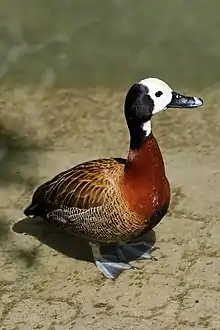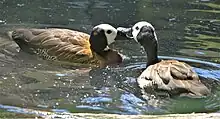White-faced whistling duck
The white-faced whistling duck (Dendrocygna viduata) is a whistling duck that breeds in sub-Saharan Africa and much of South America.
| White-faced whistling duck | |
|---|---|
 | |
| Scientific classification | |
| Domain: | Eukaryota |
| Kingdom: | Animalia |
| Phylum: | Chordata |
| Clade: | Dinosauria |
| Class: | Aves |
| Order: | Anseriformes |
| Family: | Anatidae |
| Genus: | Dendrocygna |
| Species: | D. viduata |
| Binomial name | |
| Dendrocygna viduata (Linnaeus, 1766) | |
 | |
| White-faced whistling duck range | |
| Synonyms | |
|
Anas viduata Linnaeus, 1766 | |
This species is gregarious, and at favoured sites, the flocks of a thousand or more birds arriving at dawn are an impressive sight. As the name implies, these are noisy birds with a clear three-note whistling call.
Description
The white-faced whistling duck has a long grey bill, a long head, and longish legs. It has a black neck and head, and a distinctive white face that gives it its name, though the amount of white color visible has regional variations among the species. For example, the white-faced whistling ducks with more black coloration are commonly found in western Africa where rainfall supersedes the dry season. The back and wings are dark brown to black, and the underparts are black with a fine white barring on the flanks. The neck is chestnut. Males and females have similar plumage. Juveniles are similar in color to adults but have a much less contrasted head pattern.
Range and habitat
The white-faced whistling duck has a peculiar disjunctive distribution, occurring in Africa and South America. It has been suggested that they may have been transported to new locations worldwide by humans. The habitat is still freshwater lakes or reservoirs, with plentiful vegetation, where this duck feeds on seeds and other plant food.
Because of its large range, there are many common names for the white-faced whistling duck, including "irere" and "guiriri".[2][3]
Ecology
This is an abundant species. It is largely resident, apart from local movements which can be 100 km or more.
Breeding
It nests on a stick platform near the ground and lays 8-12 eggs. Trees are occasionally used for nesting.
Conservation
The white-faced whistling duck is one of the species to which the Agreement on the Conservation of African-Eurasian Migratory Waterbirds (AEWA) applies.

Gallery


_RWD2.jpg.webp)
.jpg.webp) subadult
subadult Dendrocygna viduata - MHNT
Dendrocygna viduata - MHNT
References
- BirdLife International (2016). "Dendrocygna viduata". IUCN Red List of Threatened Species. 2016: e.T22679763A92829021. doi:10.2305/IUCN.UK.2016-3.RLTS.T22679763A92829021.en. Retrieved 12 November 2021.
- Gomez-Dallmeier, Francisco (1989). Biology, Conservation and Management of Waterfowl in Venezuela. Editorial Ex Libris. ISBN 978-980-6200-13-5.
- South American Explorer. South American Explorers Club. 1983.
- Wildfowl by Madge and Burn, ISBN 0-7470-2201-1
External links
- White-faced Whistling Duck videos, photos & sounds on the Internet Bird Collection
- Species text in The Atlas of Southern African Birds.
- 1965. Handbook of waterfowl behaviour: Tribe Dendrocygnini (Whistling Ducks) by Paul Johnsgard
- (2010) Ducks, Geese, and Swans of the World: Tribe Dendrocygnini (Whistling or Tree Ducks) by Paul Johnsgard
- Treca, B., 1981: Diet of the white-faced Tree Duck (Dendrocygna viduata) in the Senegal delta. Oiseau et la Revue Francaise d’ Ornithologie 51(3): 219-238
- Petrie, Scott A.; Rogers, Kevin H. (1 January 1997). "Activity budget of breeding white-faced whistling ducks Dendrocygna viduata on stock-ponds in semi-arid South Africa, and a comparison with north-temperate waterfowl". South African Journal of Wildlife Research. 27 (3): 79–85. hdl:10520/EJC117039.
- Menegueti, J. O., Burger, M. I., Frozi, M., Tavares, A. E., Dotto, J. C., Fontana, C. S., Ramos, R. A. & Setubal, S. S. (1988) Nota prévia sobre os comportamentos reprodutivos de Dendrocygna viduata e Dendrocygna autumnalis no norte e noroeste do Estado de São Paulo. Resumos: XV Congresso Brasileiro de Zoologia. 31/1 a 5/2/1998. p. 468. Curitiba: Universidade Federal do Paraná.
- Petrie, Scott A. (1 April 2005). "Spring body condition, moult status, diet and behaviour of white-faced whistling ducks (Dendrocygna viduata) in northern South Africa". African Zoology. 40 (1): 83–92. doi:10.1080/15627020.2005.11407313. S2CID 56074972.
- Gauthier-Clerc, Michel; Tamisier, Alain; Cezilly, Frank (1994). "Sleeping and Vigilance in the White-Faced Whistling-Duck". The Wilson Bulletin. 106 (4): 759–762. JSTOR 4163495.
- Cooke, Richard G.; Olson, Storrs L. (1984). "An Archaeological Record for the White-Faced Whistling-Duck Dendrocygna viduata in Central Panama". The Condor. 86 (4): 493–494. doi:10.2307/1366841. hdl:10088/6469. JSTOR 1366841.
- Volodin, Ilya A.; Volodina, Elena V.; Klenova, Anna V.; Filatova, Olga A. (30 June 2005). "Individual and sexual differences in the calls of the monomorphic White-faced Whistling Duck Dendrocygna viduata". Acta Ornithologica. 40 (1): 43–52. doi:10.3161/068.040.0110. S2CID 13828888.
- http://moscowzoo.ru/docs/C105_402_Klenova_et_al_2002_Berlin.pdf
- http://www.moscowzoo.ru/docs/C105_131_Volodin_et_al_2003_IZN.pdf
- http://www.the-eis.com/data/literature/Oatley_1986_SA_J_Wildl_Res_16_waterfowl.pdf
- http://horizon.documentation.ird.fr/exl-doc/pleins_textes/pleins_textes_6/colloques2/010008478.pdf
- http://www.tau.ac.il/lifesci/zoology/members/yom-tov/articles/Factors.pdf
- http://www.bsc-eoc.org/download/lpwwrf%20wfwd%20nutrients.pdf
- Friedmann, Herbert (1947). "Geographic Variations of the Black-Bellied, Fulvous, and White-Faced Tree-Ducks". The Condor. 49 (5): 189–195. doi:10.2307/1364339. JSTOR 1364339.
- Alexander, S. J.; McLaughlin, J. D. (1997). "A checklist of helminths from the respiratory system and gastrointestinal tracts of African Anatidae". Onderstepoort Journal of Veterinary Research. 64 (1): 5–16. hdl:2263/20711. PMID 9204498.
- http://digital.bl.fcen.uba.ar/Download/008_ElHornero/008_ElHornero_v010_n03_articulo209.pdf
